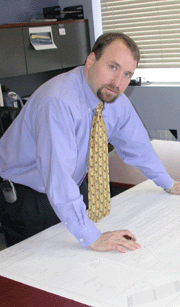E-Archive
Articles
in Vol. 6 - January Issue - Year 2005
Automation of Peen Forming for Wing Skin Fabrication - Survival of the Fittest?

Author: Guy Levaseur, President of AeroSphere Inc.
20 Years ago, the idea of drawing complete aircraft in computer & even the dream of assembling the complete aircraft before one single component was manufactured was considered ridiculous, impractical! So doubtful were aircraft manufacturer at first that complete aircraft were drawn on primitive CAD system and on paper, the conventional way, in parallel since low confidence was given to the technology that, has since then, changed the way of designing & manufacturing aircraft.
Today nobody in their right mind would even consider designing a new aircraft without solid modelling, FEM & simulation software. In the same parallel, it is the cross road peen forming is at.
Likewise peen forming is on the verge of a technological revolution. The technologies that are now immerging render this transformation possible. It is not a surprise that other technologies that once benefited from technological development have created immense pressure on the peen forming technology to move to a higher level of control & predictability. Since peen forming on wing skins is mainly manual, its survival will occur through technology application and automation.
Technology is like all progress; it has its benefits and its drawbacks. In the case of peen forming, the good grossly overweighs the bad! This being said, there is no question in my mind, having made many process certifications to various OEM that without control & repeatability, the process is becoming an annoyance more than a solution to the engineering community. This is mainly due to the complexity of the parameters requiring control for this type of manual process application.
Therefore they may be tempted to opt for other processes, that even though they are a lot less efficient, cost effective & flexible, will provide them with the control they should be expecting mainly for such large & critical components that are wing skins.
This is where peen forming has to evolve to stay alive in the next generation of aircraft being developed. In this survival of the fittest battle, the rival of peen forming is not the other forming processes, but peen forming itself. To be efficient, repeatable and cost effective, peen forming must be turned from an operator knowledge based process, to automation.
Why? The cost. Training, upgrading, re-certifying peen former is very expensive and this is not to mention the health hazards that are associated with peen forming, mainly due to constant heavy equipment manipulation and from the dust that peen forming, and associated sanding produces. The main potential long term health problems encountered are elbow injury, shoulder and back problems not only from peen forming itself but from pre-load positioning and awkward body position required to peen form large structures such as wing skins.
Today people still use peen forming, even with its actual weakness because it is cheap. Also some designs cannot be manufactured with any other process than peen forming. So it is still very efficient, but many factors are now starting to emerge that will limit the use of such manual processes.
The need to always push technology to its limit by using high yield alloys and having more and more complex curvature for better performing aerodynamics, not to mention some design feature that may have some special characteristic required for assembly or for design features like the use of “J” type stringers and continuous stringers through the dihedral requires a level of control and complexity that can only be achieved and controlled using very sophisticated peen forming techniques and control equipment.
For sure, with the knowledge that has been developed over the years for the peen forming technology, people are not going to go back to the way peen forming was controlled originally using only Almen intensity, shot size and coverage as a means of measure to control the process.
The advent of controlled pre-loading, progressive load applications and many other advanced techniques in the peen forming process renders these original variables to be only part of the equation and forces the aircraft manufacturer to rewrite and adapt their specifications to the new reality of peen forming.
Nevertheless people are only human, and with all their good will, can only be repetitive to the level that their experience and knowledge will permit. Even training new peen formers comes at a price since they must have hands-on experience to learn and that is done at the expense of the quality of the components and to a lower level of repeatability. Sadly, in these cases, training is a key component to ensure good process application and transfer but most of the time; it is the weak link in the life cycle of the process. Robots on the other hand do not require training. As the rates increase, all you need to do is "Add more of the same!"
Therefore if peen forming is to maintain itself as THE process for forming aluminium wing skins, it has to evolve to a level of technological sophistication that will ensure cost, performance, repeatability, control and documentation are in line with today’s demanding world market. These needs are required in order to provide an "ever evolving" design performance requirement and aerodynamic shape complexity specification, the best manufacturing process through on-line shot velocity/flow control, automation, adaptable software, virtual part shape determination & part positioning, the understanding of the peen forming process itself, and controlled & repeatable load application will ensure a predictable & repetitive process at a reasonable cost.
These advancements CAN, WILL and MUST be done in order to ensure the survival of this incredible process in the future of aircraft design and fabrication.
For Information:
AeroSphere Inc.
Tel. +1.514.704 0729
Fax +1.514.972 0476
E-mail: guy.levasseur@aerosphere.ca
www.aerosphere.ca



























